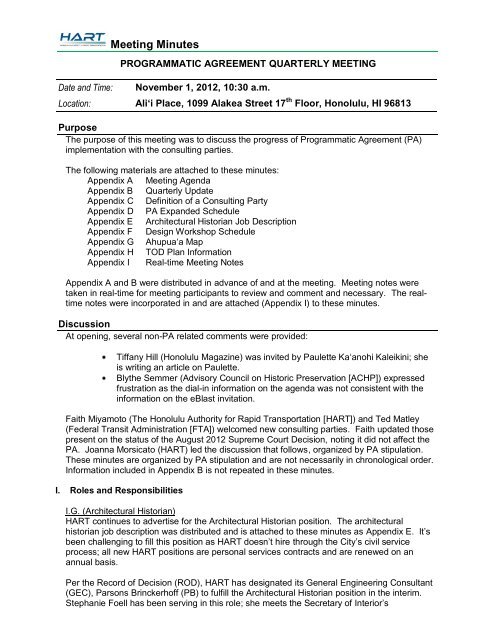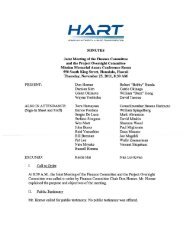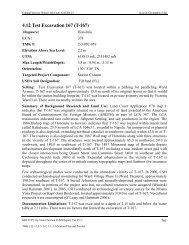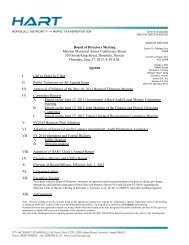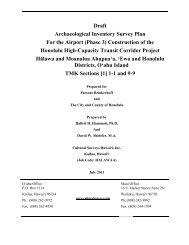Download - Honolulu Rail Transit Project
Download - Honolulu Rail Transit Project
Download - Honolulu Rail Transit Project
Create successful ePaper yourself
Turn your PDF publications into a flip-book with our unique Google optimized e-Paper software.
Date and Time:<br />
Meeting Minutes<br />
PROGRAMMATIC AGREEMENT QUARTERLY MEETING<br />
November 1, 2012, 10:30 a.m.<br />
Location: Ali‘i Place, 1099 Alakea Street 17 th Floor, <strong>Honolulu</strong>, HI 96813<br />
Purpose<br />
The purpose of this meeting was to discuss the progress of Programmatic Agreement (PA)<br />
implementation with the consulting parties.<br />
The following materials are attached to these minutes:<br />
Appendix A Meeting Agenda<br />
Appendix B Quarterly Update<br />
Appendix C Definition of a Consulting Party<br />
Appendix D PA Expanded Schedule<br />
Appendix E Architectural Historian Job Description<br />
Appendix F Design Workshop Schedule<br />
Appendix G Ahupua‘a Map<br />
Appendix H TOD Plan Information<br />
Appendix I Real-time Meeting Notes<br />
Appendix A and B were distributed in advance of and at the meeting. Meeting notes were<br />
taken in real-time for meeting participants to review and comment and necessary. The realtime<br />
notes were incorporated in and are attached (Appendix I) to these minutes.<br />
Discussion<br />
At opening, several non-PA related comments were provided:<br />
Tiffany Hill (<strong>Honolulu</strong> Magazine) was invited by Paulette Ka‘anohi Kaleikini; she<br />
is writing an article on Paulette.<br />
Blythe Semmer (Advisory Council on Historic Preservation [ACHP]) expressed<br />
frustration as the dial-in information on the agenda was not consistent with the<br />
information on the eBlast invitation.<br />
Faith Miyamoto (The <strong>Honolulu</strong> Authority for Rapid Transportation [HART]) and Ted Matley<br />
(Federal <strong>Transit</strong> Administration [FTA]) welcomed new consulting parties. Faith updated those<br />
present on the status of the August 2012 Supreme Court Decision, noting it did not affect the<br />
PA. Joanna Morsicato (HART) led the discussion that follows, organized by PA stipulation.<br />
These minutes are organized by PA stipulation and are not necessarily in chronological order.<br />
Information included in Appendix B is not repeated in these minutes.<br />
I. Roles and Responsibilities<br />
I.G. (Architectural Historian)<br />
HART continues to advertise for the Architectural Historian position. The architectural<br />
historian job description was distributed and is attached to these minutes as Appendix E. It’s<br />
been challenging to fill this position as HART doesn’t hire through the City’s civil service<br />
process; all new HART positions are personal services contracts and are renewed on an<br />
annual basis.<br />
Per the Record of Decision (ROD), HART has designated its General Engineering Consultant<br />
(GEC), Parsons Brinckerhoff (PB) to fulfill the Architectural Historian position in the interim.<br />
Stephanie Foell has been serving in this role; she meets the Secretary of Interior’s
PA Quarterly Meeting Meeting Minutes—2 November 1, 2012<br />
Professional Qualification Standards. Mason Architects and other project staff including<br />
planners and those with a background in Section 106 and/or Historic Preservation have also<br />
been participating in fulfilling this role.<br />
Angie Westfall (State Historic Preservation Division [SHPD]) commented:<br />
SHPD hired two full-time Architectural Historians and two temporary Architectural<br />
Historians within the last year. The fact that HART is not getting applications is<br />
hard for us to believe. There are people on-island that meet the standards.<br />
To address the concern that HART wasn’t responsive to PA requirements regarding <strong>Transit</strong>-<br />
Oriented Development (TOD) in lieu of a staff Architectural Historian, HART explained that it’s<br />
Planners and Mason Architects (local Architectural Historians) reviewed recently submitted<br />
draft Kalihi and Downtown Neighborhood TOD plans. Relevant portions of the draft Kalihi and<br />
Downtown Neighborhood TOD plans were distributed at the meeting and are attached to<br />
these minutes as Appendix H. Both HART and the GECs subcontractor, Mason Architects<br />
provided detailed comments to the City’s Department of Planning & Permitting (DPP) on these<br />
plans. HART also clarified that DPP has TOD implementation authority; while HART is in an<br />
advisory role and provides regular input to DPP.<br />
I.H. (PA Kāko‘o – Paul Cleghorn, Pacific Legacy)<br />
The kāko‘o holds monthly consulting party meetings that are separate from these PA<br />
Quarterly Meetings. Upcoming kāko‘o meetings will take place on November 29, 2012 and<br />
December 20, 2012. Paul noted that the kāko‘o meetings could be used for design-focused<br />
coordination; it’s an option.<br />
The kāko‘o is beginning work on the Best Practices Manual (BPM) that was mentioned at the<br />
last quarterly meeting.<br />
Mahealani Cypher (O‘ahu Council, Association of Hawaiian Civic Clubs) commented:<br />
Consulting parties feel the Best Practices Manual (BPM) related to historic<br />
properties and a Section 106 “lessons learned” case study on the <strong>Project</strong> be<br />
developed sooner than noted in the PA. Why wasn’t this done earlier We<br />
should be following this now<br />
Blythe Semmer commented:<br />
There is value in beginning to work on parts of the BPM where things are already<br />
available to us and we can think about our best practices where we currently<br />
stand. However, please note, this includes a longer-term, backward look at the<br />
implementation of this project for a case study that could be used on future<br />
projects as well. Please keep in mind that we don’t want to move it too far up to<br />
where we cut off the opportunity to continue to learn.<br />
New Consulting Parties<br />
The following individuals had previously requested recognition as a consulting party. They<br />
were invited to participate in and were recognized at this November 1, 2012 meeting.<br />
Blossom Feiteira, Rocky Naeole and Rose Puaoi were not present at the meeting.<br />
Blossom Feiteira, Association of Hawaiian Homelands<br />
Ha‘aheo Guanson, Pacific Justice and Reconciliation Center<br />
Kanaloa Koko, Royal Order of the Crown; Ka Iwi ‘Ōlelo<br />
Michael Kumukaoha Lee, Kane Hili Hui<br />
Paulette Ka‘anohi Kaleikini<br />
Rocky Naeole, Royal Order of Kamehameha-Moku ‘O Kapuāiwa (Chapter 8)<br />
Rose Puaoi, Council for Native Hawaiian Advancement<br />
Umi Sexton, Kingdom of Hawai‘i; Order of Kamehameha
PA Quarterly Meeting Meeting Minutes—3 November 1, 2012<br />
The “Definition of a Consulting Party” handout was distributed and is attached to these<br />
minutes as Appendix C.<br />
Hinaleimoana Wong-Kalu (O‘ahu Island Burial Council [OIBC]) made several comments:<br />
What was the impetus that prompted the latest wave of consulting parties at this<br />
juncture of the discussion<br />
Hopes that this is not going to create the image that more people were consulted<br />
with. “We’ve had very reasonable consultation with those all along the way up<br />
until this point; I am speaking to what degree will the concerns of those who have<br />
sat at this table be honored”<br />
In support of the new voices and those who have yet to participate.<br />
Doesn’t appreciate that the FTA holds ultimate discretion on consulting parties as<br />
they are not in the wherewithal to determine for the Hawaiian community who is<br />
and who isn’t in a position and who has a say and who doesn’t.<br />
The OIBC brought forth recommendations; had those been paid attention to and<br />
had OIBC been honored in their request to become a mandatory signatory of the<br />
PA, the injunction as a result of the latest Hawai‘i Supreme Court ruling could<br />
have been avoided.<br />
You may want to consider how you approach working with the native community.<br />
Ted Matley:<br />
FTA takes this process very seriously and is committed to making sure that what<br />
has been agreed upon in the PA is executed. He also acknowledged that FTA<br />
appreciates comments received requesting more information. The <strong>Honolulu</strong> <strong>Rail</strong><br />
<strong>Transit</strong> <strong>Project</strong> (HRTP) is a complex project and the communication process<br />
continues to be refined; we are continually working to improve communication.<br />
II. Traditional Cultural Properties (TCP)<br />
II.A. (Studies to Determine the Presence of Previously Unidentified TCPs)<br />
Michael Lee (Kane Hili Hui) commented:<br />
Kepā Maly was hired to do the Traditional Cultural Properties (TCP) Study and I<br />
provided oli and other information related to Chinatown and Honouliuli. The<br />
information never got to Kepā; it was never in the final report.<br />
Studies for Sections 1-3 have been completed and approved. Information Update (not<br />
included at meeting): The spring of Huewaipi and Kukiiau, a battle ground, were identified as<br />
National Register of Historic Places (NRHP) eligible resources. HART will complete NRHP<br />
nominations for these properties that meet the NRHP criteria for TCPs. No adverse impacts<br />
from the HRTP were identified for these properties. This information was provided to<br />
consulting parties at an earlier date.<br />
The SRI Foundation/Kumu Pono team, in partnership with Cultural Surveys Hawai‘i (CSH),<br />
continue the development of the TCP Study for City Center (Section 4; Middle Street to Ala<br />
Moana Center), which includes Chinatown and is expected to be completed in early-2013.<br />
HART will ensure the Chinatown information from Michael gets to Kepā and will need to look<br />
into the Honouliuli information that was previously provided.<br />
A general informational map showing the relationship between the HRTP guideway sections<br />
and ahupua‘a was distributed and is attached to these minutes as Appendix G.
PA Quarterly Meeting Meeting Minutes—4 November 1, 2012<br />
III. Identification and Protection of Archaeological Sites and Burials<br />
III.B (Protocol for Consultation Regarding Treatment of Iwi Kūpuna identified during the<br />
AIS)<br />
HART is seeking registered or potential cultural and/or lineal descendants. HART will hold the<br />
first in a series of Consultation for Iwi Kūpuna meetings on November 8, 2012 to discuss<br />
recent discoveries.<br />
Hinaleimoana Wong-Kalu commented:<br />
In the area of iwi kūpuna, in this district alone, there are about 10 on-going<br />
projects and she goes to each and every one of those meetings. She thought<br />
that the Hilton Hawaiian Village was holding a consultation meeting with<br />
descendants on November 8, 2012, which conflicts with the HART consultation<br />
meeting. (Information Update: this was later found to be in error. The HART<br />
meeting was held as scheduled.)<br />
III.C (Fieldwork)<br />
The Archaeological Inventory Survey (AIS) and design work is progressing while construction<br />
has been placed on hold. AIS field work completion is expected by the end of 2012. As of<br />
October 31, 2012, 168 of 232 trenches in the City Center section have been completed.<br />
Consultation with SHPD and OIBC regarding the treatment of finds at trenches 150, 141 and<br />
142 continues. If finds in these three trenches were to be left in place, the project can design<br />
the columns and utilities around these locations.<br />
Mahealani Cypher commented:<br />
Would it have been cheaper to do the full AIS before starting construction<br />
It was acknowledged that there are costs associated with construction delays.<br />
Michael Lee commented:<br />
On May 11, 2012, I submitted a Freedom of Information Act (FOIA) request:<br />
“what is the TMK map numbers and location of the current drilling area of<br />
HART’s contractors at Ho‘opili farm area for the rail pylons that recently hit<br />
water” The response received from HART: “There is no responsive record but<br />
the TMK for the area mentioned is 9-1-17:004. Please note groundwater was not<br />
encountered during drilling shafts at Pier 65 and Piers 71-76.” What of the other<br />
piers<br />
HART will respond to Mike Lee with clarification on piers that were not mentioned in HART’s<br />
response to his FOIA request.<br />
Cultural Monitoring<br />
Federal and State law, and the PA, do not require HART to have Cultural Monitors; however,<br />
HART has voluntarily developed a Cultural Monitoring Program for City Center (Section 4) AIS<br />
activities.<br />
Umi Sexton (Kingdom of Hawai‘i; Order of Kamehameha) commented:<br />
Regarding last night’s KGMB broadcast, HART’s media guy needs to be more<br />
proactive and transparent about what’s occurring on a weekly basis. Cultural<br />
Monitors are there to educate all of those involved.<br />
Ha‘aheo Guanson (Pacific Justice & Reconciliation Center) asked:<br />
Are you evaluating the Cultural Monitors
PA Quarterly Meeting Meeting Minutes—5 November 1, 2012<br />
Michael Lee asked:<br />
What has HART done to find cultural and/or lineal descendants What<br />
newspapers (Ka Wai Ola, <strong>Honolulu</strong> Star-Advertiser) have you advertised in your<br />
search Very important to get lineal descendants on board.<br />
The fact that you have people that have worked on project’s elsewhere, does not<br />
address the lineal descendants issue; there is a hierarchy of protocol.<br />
He also added that not all of us could attend the Cultural Monitoring Safety<br />
Orientation. Will there be another<br />
HART has placed legal advertisements in the Office of Hawaiian Affairs’ Ka Wai Ola<br />
newspaper and the <strong>Honolulu</strong> Star-Advertiser, and has also distributed an eBlast notification<br />
seeking cultural and/or lineal descendants. Additionally, the Native Hawaiian Chamber of<br />
Commerce and other Native Hawaiian Organizations (NHO) have been sharing the<br />
information within their network. (Also see discussion above, under Stipulation III.B regarding<br />
November 8, 2012 meeting.)<br />
At this time, additional Cultural Monitor Safety Orientation sessions are not scheduled.<br />
Paulette Kaleikini commented:<br />
Cultural Monitors should be state-recognized cultural and/or lineal descendants<br />
of the area; we come forward to be recognized in order to fully participate. She<br />
also noted that she had complaints from family members – who are Cultural<br />
Monitors – last night, who feel they are being controlled and manipulated.<br />
Kanaloa Koko (Royal Order of the Crown; Ka Iwi ‘Ōlelo) had a different opinion:<br />
Cultural Monitors can be from any district (ahupua‘a) as long as they are Native<br />
Hawaiian. No matter where you come from, a Native Hawaiian has a right to<br />
participate as a Cultural Monitor.<br />
HART is in the planning stages for a project-wide Cultural Monitoring Program for<br />
construction, and is currently working with a group of monitors, many of whom have served as<br />
monitors for other projects on O‘ahu and includes state-recognized cultural and/or lineal<br />
descendents.<br />
IV. Design Standards<br />
Ken Caswell, HART’s Chief Architect, lead the discussion on the status of the station design<br />
and value engineering that has occurred.<br />
IV. A (Design Language Pattern Book)<br />
The Design Language Pattern book has not been modified and will not be updated. It is still<br />
being utilized.<br />
Blythe Semmer commented:<br />
Referring to PA stipulation IV.A, when will the City, FTA and/or kāko‘o give an<br />
initial assessment of whether the designs for stations with the potential for<br />
cultural sensitivity and/or near historic resources (Aloha Stadium, Pearl Harbor<br />
Naval Base, Chinatown and Downtown stations) meet the Secretary of Interiors’<br />
Standards for the Treatment of Historic Properties Will we hear from you folks<br />
on or around the time of Workshop #2 that appears here on the Design<br />
Workshop Schedule<br />
Hinaleimoana Wong-Kalu asked Blythe:<br />
Please articulate for those who are new at the table, what are the sensitivities<br />
you are referring to with regards to the station and its design.
PA Quarterly Meeting Meeting Minutes—6 November 1, 2012<br />
Blythe responded to Hinaleimoana:<br />
I speak of adherence to the Secretary of Interiors’ Standards for the Treatment of<br />
Historic Properties, which is referenced in PA stipulation IV.A and relates to<br />
impacts to stations within or adjacent to listed or eligible historic properties and<br />
that the City will comply in order to avoid adverse effects, since the standards are<br />
a preservation practice. I want the consulting parties to understand when we’ll<br />
get an assessment that these designs meet those standards.<br />
Hinaleimoana Wong-Kalu made other comments:<br />
Station design should display a balance between Hawaiian and other cultures.<br />
Michael Lee commented:<br />
Cultural connections between Hawaiian and Chinese have been made; we need<br />
to continue to do this.<br />
Mahealani Cypher noted:<br />
We previously reviewed designs that were unique to each station and had<br />
suggested that external structural components reflect the host culture with<br />
Hawaiian motifs, themes and other elements. Perhaps the interiors of station<br />
entrance buildings could be the appropriate space to display the historical<br />
features and information but the exterior should clearly convey a Hawaiian sense<br />
of place.<br />
Ha‘aheo Guanson asked:<br />
Can we get assurance that the basic structural design will be Hawaiian<br />
Michael Lee inquired:<br />
What happens to elevators and/or escalators in the event of a power outage Is<br />
there emergency power<br />
Ken Caswell responded:<br />
Typically, elevators are not on uninterrupted power. In the event of a power<br />
outage, elevators usually return to the ground floor. There will be patron-assisted<br />
telephones at each station to contact the operations control center, which would<br />
dispatch emergency responders. HART will institute processes and procedures<br />
to address an island-wide power outage that is of significance. HART has<br />
ongoing safety and security meetings that involve staff across multiple disciplines<br />
and will work with the <strong>Honolulu</strong> Police Department (HPD) and Emergency<br />
Medical Technicians (EMT) to design features, training programs, etc that will<br />
mitigate any emergency situation that may arise.<br />
Paulette Ka‘anohi Kaleikini asked:<br />
How many restrooms per station<br />
Ken Caswell responded:<br />
One per station. Restrooms are not required. However, there will be one unisex<br />
restroom at each station, which will be locked but accessible via the station<br />
attendant. HART has polled other transit agencies/systems and many have been<br />
compelled to close existing restrooms due to criminal activities, homelessness<br />
and other issues. The catch-22 is that restrooms at stations can be more of a<br />
hazard than a convenience to patrons.<br />
The consulting parties offered a number of comments regarding restrooms:<br />
Michael Lee suggested: Install a camera outside of the restroom like on TheBus.<br />
If they knew that they were being watched, it would tell the patron that we have a<br />
timed record of you.<br />
Ellyn Goldkind noted: There’s no way to deter bad activity; people will spray paint<br />
or break the camera. She continued that in Washington, D.C. there is one<br />
restroom at each station, which the public can access through the stations onsite<br />
manager. She also commented that since travel time between stations is<br />
fairly short, that not too many real emergencies would occur.
PA Quarterly Meeting Meeting Minutes—7 November 1, 2012<br />
Kalani Asam said - applying mainland standards to Hawai‘i dismisses the Aloha<br />
spirit; that’s what distinguishes us from “them.”<br />
Kanaloa Koko asked: have you considered a token system for access to<br />
restrooms<br />
URS Corporation was given a notice to proceed as the West O‘ahu Station Group (WOSG)<br />
Design Consultant in July 2012. WOSG includes East Kapolei, UH West O‘ahu and Ho‘opili<br />
stations.<br />
Ellyn Goldkind made several comments:<br />
“You anticipate a notice to proceed on Kamehameha Highway Station Group<br />
(KHSG) but we have yet to review the designers’ Request for Proposal (RFP),<br />
which we requested in July 2012. Additionally, in February or May of 2011, we<br />
requested a design charette.” She wants to see the designers’ scope of work.<br />
“I was told that URS was brought on board to develop modular design.”<br />
She is concerned that URS is WOSG design consultant. “I have a lot of years of<br />
experience in working with URS. I have never seen a good contextual design<br />
from URS; they’re more of an engineering firm.”<br />
She has asked who on the URS team has cultural and local design experience<br />
and has gotten no answer.<br />
URS is not tasked with developing modular design. There is confidentiality in the consultant<br />
selection process so not all information is available. HDR Engineering, Inc was given prior<br />
notice to proceed as the Farrington Highway Station Group (FHSG) Design Consultant.<br />
FHSG includes West Loch, Waipahu and Leeward Community College stations. Given valueengineering<br />
(VE) efficiencies that have been instituted, design for the FHSG is going through<br />
re-design based on modular design.<br />
Hinaleimoana Wong-Kalu commented:<br />
We’ve been discussing this for two years. This process is unacceptable in the<br />
Hawaiian community context. My community and people have seen an influx for<br />
too long and so now the standards are that any building over x-number of years<br />
old meets the standards. Case in point, Chinatown buildings determining the<br />
appearance of the Chinatown Station instead of honoring the native culture and<br />
history.<br />
Ellyn Goldkind responded to Hinaleimoana’s comment:<br />
It’s supposed to do both. You’re supposed to see contextual in the design and<br />
still find a way to incorporate that homage to the past, including the native<br />
Hawaiian past. It’s not just the built environment that exists, it’s everything.<br />
Ellyn Goldkind commented:<br />
We were told that the VE exercise was to develop a modular kit of parts but I<br />
expected that by now we would have some conceptual notion of what those kit of<br />
parts would be (i.e. exterior panels that could incorporate Hawaiian motifs, color<br />
and materials palette). As a VE decision, these affect the cost of the entire run of<br />
the station design. That kit of parts may not apply to the Pearl Harbor Naval<br />
Base Station and it’s my job to ensure that they are identified and addressed<br />
early on in the process to avoid change orders, etc.<br />
IV.B (Neighborhood Design Workshops)<br />
The Design Workshop Schedule was distributed and is attached to these minutes as<br />
Appendix F. Workshop #1 is intended to capture the Preliminary Engineering (PE)-level<br />
designs, or at least the revised PE-level designs. Workshop #2 is at the stage of Final Design<br />
for the stations and will include all features, stipulations, codes, regulations, ordinances, etc.
PA Quarterly Meeting Meeting Minutes—8 November 1, 2012<br />
A design workshop for FHSG will be held in February 2013 to discuss architectural drawings,<br />
features and finishes. A design workshop for WOSG will be held in June 2013 to discuss<br />
exterior appearances and aesthetic features.<br />
IV.C (Preliminary Engineering Design Plans)<br />
Angie Westfall commented:<br />
According to the schedule, WOSG and FHSG held their first in a series of design<br />
workshops, presenting PE-level designs. SHPD has not seen any PE design<br />
submittal(s) for built components including stations, guideway, and directly<br />
related project infrastructure improvements. My concern is that you will be<br />
presenting updated designs that you consider to be final when I haven’t reviewed<br />
any PE-level designs.<br />
Ellyn Goldkind recalled that:<br />
We’ve reviewed and commented in February 2011 but haven’t seen anything<br />
graphic. Also, given the new design approach, previous design reviews are null<br />
and void. Since we’re starting over, let’s start over the right way.<br />
Mahealani Cypher noted:<br />
We see this group once every quarter and have been asking for design<br />
information for too long. It would’ve been helpful to see something at this<br />
meeting.<br />
Ken Caswell asked that the Navy provide him with a list of requested design deliverables so<br />
that HART can respond appropriately and provide the available information.<br />
PE-level design drawings to determine sites, locations and establish cost-estimates for<br />
individual stations were developed in 2009 and distributed to consulting parties for review (on<br />
February 25, 2011 and HART received comments from the U.S. Navy, Historic Hawai‘i<br />
Foundation and the Office of Hawaiian Affairs. Those comments are also available on the<br />
project website). The VE process was conducted on PE-level designs and HART has<br />
instituted a modular design concept with some standards features and components (i.e. stairs,<br />
elevators, escalators). However, each station will have a different site condition and aesthetic;<br />
the exterior appearance including materials and finishes can be different from station to<br />
station. Each site will have the opportunity to develop a unique character. Furthermore,<br />
entrance buildings, interpretive signage and the art-in-transit program provide additional<br />
opportunities for creating a unique aesthetic for each station.<br />
While designs were presented in 2009, the process is moving along and HART continues to<br />
re-evaluate the station configuration and technical and structural aspects to ensure design is<br />
efficient. As the final design process continues, HART will provide additional opportunities for<br />
review. Final design review opportunities will also be available for stations with the potential<br />
for cultural sensitivity and/or near historic resources (Aloha Stadium, Pearl Harbor Naval<br />
Base, Chinatown and Downtown stations).<br />
HART will present PE-level designs for FHSG and WOSG to consulting parties as soon as it<br />
becomes available, and will clarify the schedule. While the approach has changed since the<br />
initial review of PE-level designs, Workshop #2 for FHSG and WOSG will function as<br />
Workshop #2 but will actually be at a Workshop #1 level where revised PE-level designs will<br />
be presented and discussed.
PA Quarterly Meeting Meeting Minutes—9 November 1, 2012<br />
Joanna Morsicato responded that since there are so many questions about the station design<br />
and the PA, HART will schedule a project-wide station design-focused meeting to update the<br />
consulting parties before station design workshops resume.<br />
Re-internment Sites:<br />
Chapter 11: Landscape Architecture of the Compendium of Design Criteria will be updated to<br />
include a designated re-internment site at each station.<br />
Station Naming:<br />
HART intends to use a Hawaiian place name as well as location name for stations. This<br />
overlaps with Stipulation VII. There is already a City Council resolution in support of this.<br />
V. Recordation and Documentation<br />
Historic Context Studies (HCS), Cultural Landscape Reports (CLR) and Historic American<br />
Building Survey (HABS), Historic American Engineering Record (HAER), and Historic<br />
American Landscape Survey (HALS) Recordation continues.<br />
VI. National Register of Historic Places/National Historic Landmark Nominations<br />
National Register (NR) nomination and HABS, HAER, HALS (HHH) documentation continues.<br />
VI.F (Searchable Database of Historic Properties)<br />
Once information from NR nominations and HHH documentation is finalized and approved, it<br />
will be uploaded to the searchable database of historic properties under the corresponding<br />
property. The database is live at http://historic.honolulutransit.org.<br />
VII. Educational and Interpretive Programs, Materials and Signage<br />
Mahealani Cypher noted:<br />
HART should consider other venues for sharing information like a mobile<br />
application.<br />
Hinaleimoana Wong-Kalu:<br />
I will continue to hold the project team accountable. Put Hawai‘i out there in an<br />
appropriate way, but don’t prosecute it.<br />
Concerns of the native community should be first and foremost. If at all levels, in<br />
all sense of the word, that the history, culture and people of Hawai‘i does not take<br />
precedence then this is not a project worth supporting. Tourism could benefit<br />
from this; they would want this experience. I would like to be a positive support<br />
to this project and continue to do so for as long as this project will provide cultural<br />
relevant:<br />
1. Accessibility<br />
2. Visibility; and<br />
3. Opportunity<br />
VIII.<br />
Mitigation for Specific Historic Properties<br />
No update
PA Quarterly Meeting Meeting Minutes—10 November 1, 2012<br />
IX. Measures to Address Reasonably Foreseeable Indirect and Cumulative Effects Caused<br />
by the <strong>Project</strong><br />
IX.B (Historic Preservation Committee [HPC])<br />
The next HPC will take place on December 11, 2012. The HPC is still discussing the<br />
distribution of $2 million in preservation funds.<br />
X. Construction Protection Plan<br />
No update<br />
XI. City Contractors and Contract Adherence to PA<br />
No update<br />
XII. Post-Review Discoveries<br />
No update<br />
XIII.<br />
Public Information<br />
XIII.A (Semi-Annual Report)<br />
See Stipulation XIV.E.3.<br />
XIV.<br />
Administrative Provisions<br />
XIV.A (Implementation Schedule)<br />
HART had previously provided a schedule with key milestones but has since received<br />
numerous requests for a more detailed schedule with every deliverable of the PA and major<br />
milestones. The PA Expanded Schedule was distributed and is attached to these minutes as<br />
Appendix D.<br />
Ellyn Goldkind<br />
I want a real schedule with milestone and deliverable dates that align with the<br />
PA. And, those dates should identify if they are behind schedule, ahead of<br />
schedule or on-schedule with the PA.<br />
Joonsik Maing (FTA) requested that:<br />
Since there were a few meeting dates mentioned to please send an eBlast of all<br />
upcoming PA meetings.<br />
XIV.E (Monitoring and Reporting)<br />
Consulting parties had previously brought forth concerns with accurate and timely minutes.<br />
Hinaleimoana Wong-Kalu noted that:<br />
Reviewed past minutes and they are not entirely inclusive. There are things that<br />
are omitted. Noting that HART recorded comments live in on a monitor, she<br />
comments that the words made it seem she was nicer than she may have come<br />
across in the meeting.<br />
Angie Westfall noted that:<br />
SHPD submitted a letter to FTA; will we be getting a response
PA Quarterly Meeting Meeting Minutes—11 November 1, 2012<br />
Joanna Morsicato committed that HART will produce quarterly meeting minutes in a more<br />
timely fashion. She also noted that SHPD will receive a formal response to their October 15,<br />
2012 letter to FTA.<br />
XIV.E.2 (Quarterly Meetings)<br />
The next meeting, a semi-annual meeting, will take place on January 25, 2012. HART will<br />
extend the quarterly meeting schedule to continue as needed, beyond the 24-month period<br />
dictated by the PA.<br />
XIV.E.3 (Semi-Annual Report)<br />
The July 2012 Semi-Annual Report was distributed on October 19, 2012 and is available on<br />
the project website.<br />
Blythe Semmer commented:<br />
In order to be most productive, it would be helpful to review the semi-annual report and<br />
meeting handouts/materials at least a week in advance of these meetings. We want to<br />
come prepared to these meetings with questions.<br />
Other Discussion Items<br />
Hinaleimoana Wong-Kalu<br />
Would hate for the Hawaiian community to be the evil face of the project.<br />
Integrity is important.<br />
As the chair of the OIBC, I’ve had people come to me saying “stop the rail.” I’m<br />
not trying to stop anything; I’m only availing my time to be an advocate for my<br />
charge and I don’t want to be labeled as a Hawaiian that’s adversarial to<br />
development. It’s about the integrity we bring to the table.<br />
HART’s public information and media time needs to be more hands-on.<br />
Mahealani Cypher<br />
We are here to ensure that you are educated and informed to be able to make<br />
good decisions.<br />
Kalani Asam<br />
We should be in charge.<br />
*** Meeting adjourned at 1:00 pm ***<br />
Action Items<br />
HART to fill Architectural Historian position<br />
Kāko‘o to start developing Best Practice Manual (BPM) and Lessons-Learned Case<br />
Study<br />
HART to schedule a consulting party project-wide station design-focused meeting that<br />
ahead of the Station Group Design Workshops<br />
HART to provide Chinatown information from Mike Lee to Kepā Maly for TCP Study for<br />
Section 4<br />
HART will respond to Mike Lee with clarification on piers that were not mentioned in<br />
HART’s response to his FOIA request.<br />
Ellyn Goldkind asked who on the URS design team has cultural and local experience<br />
and for URS’ scope of work<br />
Request to include schedule with milestones and deliverable dates that identifies<br />
whether they’re behind schedule, on schedule or ahead of schedule<br />
Navy to provide a list of requested design deliverables to Ken Caswell<br />
HART to provide consulting parties with PE-level designs for WOSG and FHSG once<br />
available, and to clarify schedule
PA Quarterly Meeting Meeting Minutes—12 November 1, 2012<br />
eBlast of upcoming PA meetings<br />
Respond to SHPD letter to FTA<br />
HART will follow-up on request for design charette for Navy at Pearl Harbor<br />
Attending Consulting Parties<br />
Angie Westfall<br />
Ellyn Goldkind<br />
Ha‘aheo Guanson<br />
Hinaleimoana Wong-Kalu<br />
Kalani Asam<br />
Kanaloa Koko<br />
Mahealani Cypher<br />
Michael Kumukauoha Lee<br />
Paulette Ka‘anohi Kaleikini<br />
Susan Lebo<br />
Umi Sexton<br />
Dial-In Consulting Parties<br />
Blythe Semmer<br />
Joonsik Maing<br />
Ted Matley<br />
Individual Attendees<br />
Tiffany Hill<br />
Attending <strong>Project</strong> Staff<br />
Anna Mallon<br />
Bruce Nagao<br />
Faith Miyamoto<br />
Joanna Morsicato<br />
Kaleo Patterson<br />
Ken Caswell<br />
Barbara Gilliland<br />
Gary Omori<br />
Jason Bright<br />
Josh Silva<br />
Lawrence Spurgeon<br />
Elizabeth L. Kahahane<br />
Paul Cleghorn<br />
State Historic Preservation Division (SHPD)<br />
NAVFAC HI, Navy Region Hawai‘i<br />
Pacific Justice and Reconciliation Center (PJRC)<br />
O‘ahu Island Burial Council (OIBC)<br />
PJRC<br />
Royal Order of the Crown; Ka Iwi ‘Ōlelo<br />
O‘ahu Council, Association of Hawaiian Civic Clubs<br />
Kane Hili Hui<br />
SHPD<br />
Kingdom of Hawai‘i; Order of Kamehameha<br />
Advisory Council on Historic Preservation<br />
Federal <strong>Transit</strong> Administration-Region IX<br />
Federal <strong>Transit</strong> Administration-Region IX<br />
<strong>Honolulu</strong> Magazine<br />
<strong>Honolulu</strong> Authority for Rapid Transportation (HART)<br />
HART<br />
HART<br />
HART<br />
HART<br />
HART<br />
Parsons Brinckerhoff (PB)<br />
PB<br />
PB<br />
PB<br />
PB<br />
Pacific Legacy, Inc.<br />
Pacific Legacy, Inc.
PA Quarterly Meeting Meeting Minutes—13 November 1, 2012<br />
Appendix A<br />
Meeting Agenda
PA Quarterly Meeting Meeting Minutes—14 November 1, 2012<br />
Appendix B<br />
Quarterly Update
PA Quarterly Meeting Meeting Minutes—15 November 1, 2012<br />
Appendix C<br />
Definition of a Consulting Party
PA Quarterly Meeting Meeting Minutes—16 November 1, 2012<br />
Appendix D<br />
PA Expanded Schedule
PA Quarterly Meeting Meeting Minutes—17 November 1, 2012<br />
Appendix E<br />
Architectural Historian Job Description
PA Quarterly Meeting Meeting Minutes—18 November 1, 2012<br />
Appendix F<br />
Design Workshop Schedule
PA Quarterly Meeting Meeting Minutes—19 November 1, 2012<br />
Appendix G<br />
Ahupua‘a Map
PA Quarterly Meeting Meeting Minutes—20 November 1, 2012<br />
Appendix H<br />
TOD Plan Information
PA Quarterly Meeting Meeting Minutes—21 November 1, 2012<br />
Appendix I<br />
Real-time Meeting Notes


